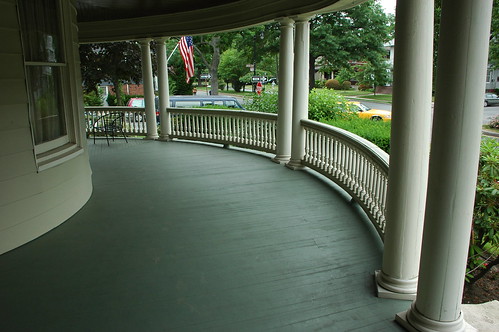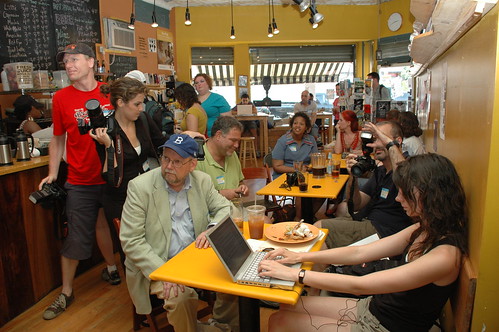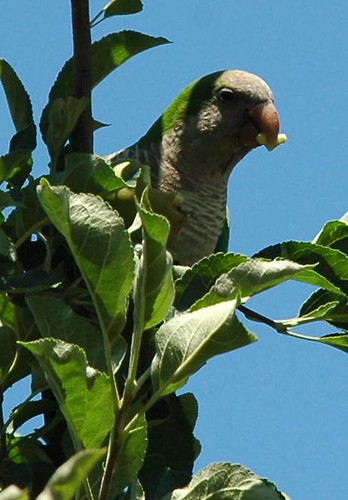Update 2009.05.09: Cellophane Bees Return
Update 2008.05.28: Many thanks to John Ascher for the id!
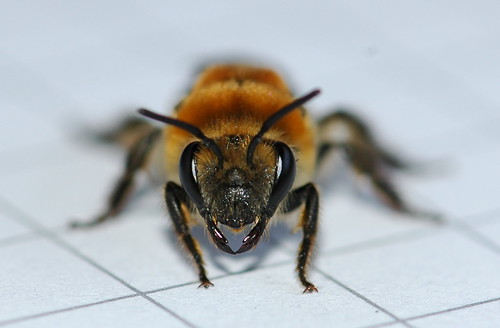
While spending most of the weekend gardening, I discovered that the garden is home to a small colony of mining cellophane bees. At first I thought they Andrenidae, mining bees, based on photos and this description on BugGuide.Net:
Many small, ground-nesting bees observed in areas of sandy soil are members of the family, Andrenidae. Characteristics of this family (of which there are approximately 3000 species) are: Small size, 20 mm, (or smaller) brown to black in color, and nesting in a burrow in areas of sparse vegetation, old meadows, dry road beds, sandy paths. Although the nests are built in close proximity of one another, the bees are solitary (each female capable of constructing a nest and reproducing). Many species are active in March and April when they collect pollen and nectar from early spring blooming flowers. The female bee digs a hole 2-3 inches deep excavating the soil and leaving a pile on the surface. She then digs a side tunnel that ends in a chamber (there are about 8 chambers per burrow). Each chamber is then filled with a small ball of pollen and nectar. An egg is laid on the top of each pollen ball and the female seals each brood chamber. The emerging larval bees feed on the pollen/nectar ball until they pupate.
– Family Andrenidae – Mining Bees, BugGuide.Net
I contacted Kevin Matteson, contact person for the Bee Watchers 2008 project here in NYC. I wasn’t able to attend any of their orientation session last week, so I forwarded him a link to this post. He in turn forwarded the link to his “colleague at the museum.” Thus turned out to be John Ascher, a BugGuide contributing editor, and all-around big bee guy, who identified the species in the first comment below. Considering I don’t have a Ph.D. in Entomology, I don’t feel so bad.
[Colletes] are virtually indistinguishable from some of the Andrenidae mining bees. Colletes are honey bee size, and have dramatic black and white banding on the abdomen. Some andrenids have similar markings, but are usually slightly smaller. Colletes tend to nest in dense aggregations, while andrenids are not usually as populous.
– Genus Colletes – Cellophane Bees, BugGuide.Net
I noticed the first entrance mound a couple of weeks ago, shortly after I put up the bat house. I saw a discoloration on the ground directly below the bat house, and thought it might be guano. On closer inspection, I thought it was an anthill.
This weekend, I was doing a lot of work near that corner of the house, and the presence of bees was more obvious, especially when I started digging up and dividing perennials (Hemerocallis and Hosta) from a bed I was preparing for a new sunny native plant border.
I also noticed that the bees were entering and leaving what I had taken to be ant hills. Here’s the area where they’re all nesting. There are six entrance holes visible in this photo. There are a couple more hidden beneath leaves. The area is less than a square foot.

Here’s a closer view of the three entrances to the left. Zoom in and check out the leftmost one. There’s a little bee in there checking me out.

When I saw all this activity around numerous holes, I thought I might have a hive. Since they’re adjacent to the house, I was worried that they might move in. Before I did anything with them, I wanted to identify them to find out what they were.
To photograph this individual, I captured it in a plastic jug and placed it in the refrigerator for a few hours. When I retrieved it, it was inert, and I first feared I had killed it. When I took it into the backyard, where temperatures were still in the 70s, thankfully it slowly revived. I placed it on a piece of graph paper from my notebook for scale. The squares are 1/4″.
Here are two more views of the same individual. When I was done, I returned it back to the nesting area. Not realizing these are solitary bees, I thought it would return to the hive. It flew off, instead. I hope it returns and is able to find its own nest, again.
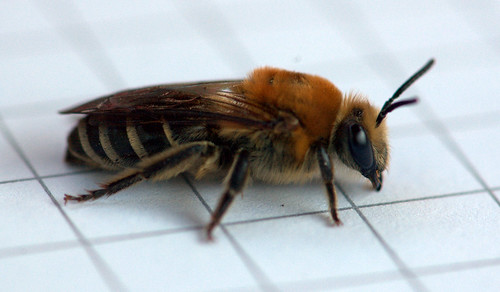

I want to take some more shots. I think I can get a shot of the wing venation without harming the individual. I’ll be more careful to not keep the subject away from its nest for so long next time. Maybe only a half-hour of chilling is all I would need to get my shots.
I’m not satisfied with the depth of field (DOF) in any of these shots. My macro lens has a focal length of 105mm (digital, around 150mm equivalent 35mm), which compresses DOF. Using the flash helped a lot. A tripod would be better. I’ll try some different options on my next attempts.
Links
Colletes thoracicus, Discover Life
Bee Watchers 2008
Family Andrenidae – Mining Bees, BugGuide.Net







